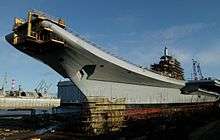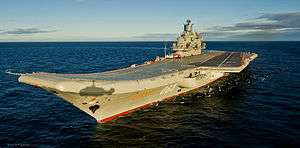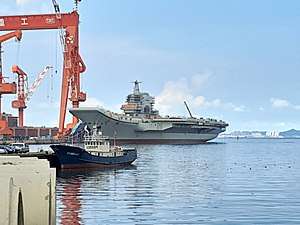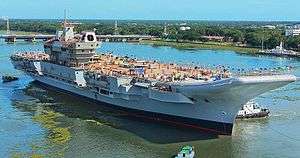STOBAR

STOBAR (Short Take-Off But Arrested Recovery) is a system used for the launch and recovery of aircraft from the deck of an aircraft carrier, combining elements of both short take-off and vertical landing (STOVL) with catapult-assisted take-off but with arrested recovery (CATOBAR).
Aircraft launch under their own power using a ski-jump to assist take-off (rather than using a catapult). However, these are conventional, rather than STOVL aircraft, and thus require arrestor wires to land on the ship. The STOBAR system is simpler to build than CATOBAR. As of 2015, it has only been used regularly on Russian, Indian, and Chinese carriers.
Advantages
Compared to CATOBAR, STOBAR is less expensive to develop. It is easier to operate than a CATOBAR configuration which requires large number of operators to launch the aircraft. Lack of any moving parts in ski-jump makes it less expensive to maintain the launch system.[1][2] It does not require any additional system to generate force required to launch the aircraft unlike CATOBAR where an external force is needed to be generated either from steam catapult[3] or Electromagnetic Aircraft Launch System (EMALS)[4] to launch the aircraft.
Limitations

One major limitation of STOBAR configuration is that it only works with fighter aircraft that have a high thrust to weight ratio such as Su-33 or MiG-29K and thus limits the kind of aircraft that can be operated from the carrier. It is not known what restrictions ski-jump takeoff implies on maximal aircraft weight. According to some sources, in order to become airborne, the aircraft may be required to limit its weaponry and fuel package in order to reduce the launch weight of the aircraft.[1][5] However according to other sources,[6] the Super Hornet can take-off from a ski-jump with a significant weapons load. Using ski-jump can limit the ability to conduct sorties faster on STOBAR aircraft carrier.[7] STOBAR carriers must maintain a speed of 20kn-30kn in order to generate wind speed required on deck which is essential for conducting aircraft launch operations.[8]
List of STOBAR aircraft
- HAL Tejas - The Naval Tejas is a variant of HAL Tejas Developed for Indian navy. A prototype (np-1) is currently under flight testing.[9][10][11]
- Mikoyan MiG-29K - currently active with the Indian Navy and the Russian Navy.
- Shenyang J-15 - operated by People's Liberation Army Navy on Liaoning[12]
- Sukhoi Su-33 - Developed from Su-27 and only operated by the Russian Navy.
Users
As of October 2018, three countries currently operate STOBAR type carriers; Russia is the only country that has built a STOBAR ship for operation, while both India and China have procured STOBAR ships that were built by Russia and have had them converted for their own use. However, both India and China are in the process of building their own STOBAR carriers.
Active STOBAR Aircraft Carriers
| Class | Image | Origin | No.of ships | Propulsion | Displacement | Operator | Aircraft Carried | Notes |
|---|---|---|---|---|---|---|---|---|
| Admiral Kuznetsov |  |
Soviet Union | 1 | Steam turbine | 58,000 tons | Russian Navy | ||
| 1 | People's Liberation Army Navy | |||||||
| Kiev |  |
Soviet Union | 1 | Steam turbine | 45,500 tons | Indian Navy | Built as STOVL carrier and converted to STOBAR | |
| Type 001A |  |
China | 1 | Steam turbine | 55,000 tons | People's Liberation Army Navy |
Undergoing sea trials[13] |
Upgraded Kuznetsov type design |
| Under Construction | ||||||||
| Vikrant |  |
India | 1 | Gas turbine | 40,000 tonnes | Indian Navy | ||
References
- 1 2 "What are carriers ?".
- ↑ "CHINA'S AIRCRAFT CARRIER AMBITIONS (page 20)".
- ↑ "STEAM-POWERED CATAPULTS" (PDF).
- ↑ "EMALS: Next Gen Catapult".
- ↑ "How Effective Will China's Carrier-Based Fighters Be?".
- ↑ "Now Navy wants Super Hornets too".
- ↑ "US-India Collaboration on Aircraft Carriers: A Good Idea?".
- ↑ "Indian Navy seeks EMALS system for second Vikrant-class aircraft carrier".
- ↑ "LCA naval variant's first flight on Friday". Archived from the original on 2 February 2014.
- ↑ "Maiden flight by 2nd prototype of LCA Tejas' naval variant".
- ↑ "Naval Version of Light Combat Aircraft Rolls out a Defining and Memorable Occasion for the Nation – Antony".
- ↑ "J-15 successfully landed on China's carrier Liaoning: Navy".
- ↑ "China's first home-grown carrier begins maiden sea trial". South China Morning Post. Retrieved 2018-06-12.